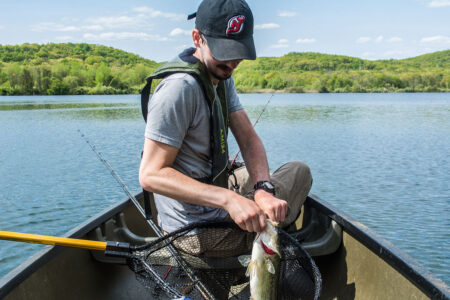
How yesterday’s rains might affect fishing today and tomorrow.
Do you think it rained some during the late winter and spring of 2024? It seemed like there were monsoons and huge rain totals every weekend with companion downpours and showers much of the week following. In many instances these rainfalls made fishing difficult to near impossible. Rivers and creeks rose past flood levels and the flows often lasted many days without subsiding. Basements and roadways saw piled up water and levels were described as “historic.” Sometimes it felt like we needed an ark!
If your favorite streams turned into raging whitewater, this was a doom and gloom scenario for sure. Despite the difficult stretch in freshwater fishing, there were and are actually fishable waters and strategies should one choose to fish within these conditions.
If a rainfall is extreme, anglers will have to seek out waters that can still get fished with such an influx of water. Not every stream will be fishable and finding these spots takes some effort and experience. Trout streams that don’t contain as much decline from the headwaters are worthy targets as they may flow just slow enough in spots to present baits. Fishermen should cast to any waters that appear more sluggish than the rest. This could be pockets behind boulders or rocky gatherings along small areas out of the main flow that can exist around bends and oxbows. Swirling water that reverses current direction and can look like a boil are good visuals to seek. Trout casters will also want to try the headwaters themselves.
Not all, but some creeks are more doable where their genesis and that might be all that is needed to provide trout an opportunity to eat. Moreover, small tributaries are outstanding options to catch trout when nature is highly unfavorable. Deeper pools and pockets below fast water may catch. Locations that may not have produced before on the streams may suddenly turn terrific when submerged. Trout streams that traverse meadows or marshes in the valleys often have slower flows and their surrounding boundaries can absorb flood waters that can expand out past their normal boundaries. They are worth a look after extreme rain. Creeks in gorges between steep vertical rises usually are difficult following heavy rain, but also possess the ability to regain moderate form a couple days following a weather event.
Again, after the heaviest of rains, trout will hold in places that may not have had trout prior. New pockets are formed, different structure that was high and dry may get half way submerged supplying new crevices and current eddies for fish to hide. Casts to edges, contours and hiding spots count more than ever before in high water.
Whether it’s the steady, consuming rain that many of us saw this spring, or simply mild precipitation, anglers must become familiar with each’s stream’s personality. Many of the well-known waters are monitored by the United States Geological Survey and cubic feet of water per second is noted day to day in a graph. Learning what flow is too much to catch versus what is acceptable can help anglers plan their outings accordingly. In fact, those graphs will show which streams lose their excess water quickly therefore becoming fishable hours or days after torrential rain.
Some of the biggest, wild brown trout are caught following rain. Slight to modest stain to the water makes the wise, old browns more aggressive toward flies and lures whereas clear water conditions make them more apprehensive to chase away from their staging spots. Flies that mimic terrestrials such as crickets, worms, ants and grasshoppers are good choices because those insects get washed into the water. Larger streamers may also work better in stained water. Jerk baits are usually productive in any conditions; however, they may shine more when pulled back toward the angler from faster current existing downstream.
Light rain or showers during a fishing outing can spark a bite if things are slow. I’ve been on many expeditions where I had a soft brook or brown trout bite when the skies got gray and the rain began. In many instances, the bite accelerated from a slow or decent pick to some truly excellent fishing. Furthermore, many of the folks using a stream go home due to the declining weather, which in turn, makes the trout less leery. Kids, swimmers, dogs and joggers alongside a stream are definitely a nemesis to good trout fishing.
And if all else fails, fishermen can target lakes or reservoirs as opposed to rivers and streams. The higher level won’t translate into questionable creek conditions.



